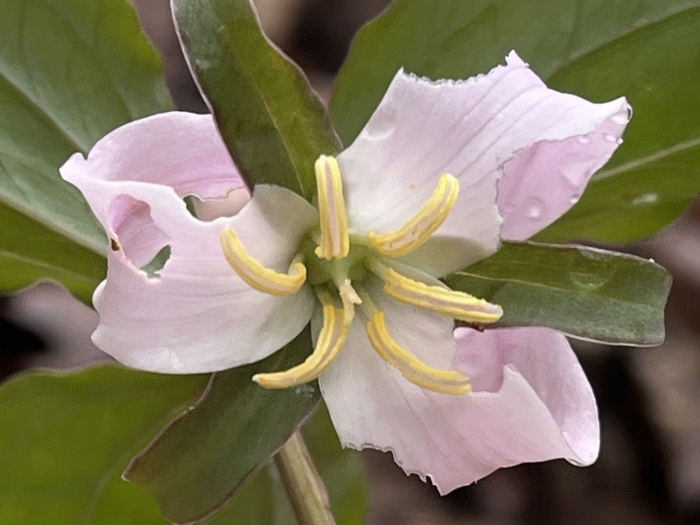Bashful Wakerobin
(Trillium catesbaei)
Bashful Wakerobin (Trillium catesbaei)
/
/

Brian Finzel
CC BY-SA 4.0
Image By:
Brian Finzel
Recorded By:
Copyright:
CC BY-SA 4.0
Copyright Notice:
Photo by: Brian Finzel | License Type: CC BY-SA 4.0 | License URL: http://creativecommons.org/licenses/by-sa/4.0/ | Rights Holder: Brian Finzel | Publisher: iNaturalist | Date Created: 2022-04-18T17:07:42Z |






















Estimated Native Range
Summary
Trillium catesbaei, commonly known as bashful wakerobin or rosy wake-robin, is a perennial herb that emerges in early spring, primarily in rich deciduous forests and along forest streams in the southeastern United States. Its range extends from the Great Smoky Mountains through parts of North Carolina and Tennessee, reaching as far south as Escambia County, Alabama. This species typically grows up to 18 inches tall and spreads slowly via underground rhizomes. The plant features a single, erect stem topped with a whorl of three broad leaves and a solitary flower. The flowers are initially white, pink, or rose-colored and may deepen to a darker pink with age. They are positioned above the leaves and can sometimes appear to be hiding behind the green or yellow bracts, which contributes to the "bashful" aspect of its common name.
Trillium catesbaei is valued for its delicate, nodding flowers that add a subtle charm to shade gardens and woodland settings. It is often used in native plant gardens and naturalized areas. Gardeners appreciate this species for its low maintenance and its ability to thrive in part to full shade, preferring moist, well-drained, humus-rich soil. While it is not drought-tolerant, once established, it requires little care. There are no significant disease or pest issues, but deer browsing can be a problem. It is important to note that Trillium species can take several years to flower from seed and should not be harvested from the wild due to their slow reproductive rate and habitat destruction concerns.CC BY-SA 4.0
Trillium catesbaei is valued for its delicate, nodding flowers that add a subtle charm to shade gardens and woodland settings. It is often used in native plant gardens and naturalized areas. Gardeners appreciate this species for its low maintenance and its ability to thrive in part to full shade, preferring moist, well-drained, humus-rich soil. While it is not drought-tolerant, once established, it requires little care. There are no significant disease or pest issues, but deer browsing can be a problem. It is important to note that Trillium species can take several years to flower from seed and should not be harvested from the wild due to their slow reproductive rate and habitat destruction concerns.CC BY-SA 4.0
Plant Description
- Plant Type: Herb
- Height: 0.6-1.75 feet
- Width: 0.75-1 feet
- Growth Rate: Slow
- Flower Color: Pink, White
- Flowering Season: Spring
- Leaf Retention: Deciduous
Growth Requirements
- Sun: Part Shade, Full Shade
- Water: Medium
- Drainage: Medium
Common Uses
Bee Garden, Butterfly Garden, Low Maintenance, Potted Plant, Rock Garden
Natural Habitat
Rich deciduous forests and forest streams in the southeastern United States
Other Names
Common Names: Catesby’s Trillium, Bashful Trillium, Catesby’S Wakerobin, Rosy Wake-robin
Scientific Names: , Trillium catesbaei, Delostylis cernuum, Delostylis stylosum, Trillium affine, Trillium balduinianum, Trillium declinatum, Trillium nervosum, Trillium stylosum,
GBIF Accepted Name: